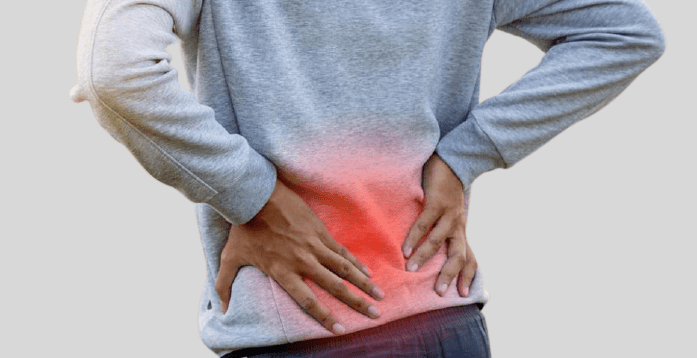As an Amazon Associate. We get small commissions for purchases made through affiliate links in this post at no extra cost to you. More info. Amazon Affiliate Disclaimer

Low back pain is one of the most common problems for people, and it is also one of the most common reasons for visiting a doctor, especially in these days.
Of course, many reasons cannot be summed up in one article, some of which are due to problems in the internal organs such as reproductive problems or kidney problems, and other diseases.
Some of them are due to mechanical, structural, or neurological problems such as muscle problems in the lower back, spine, and disc.
Lower back pain can usually be prevented by preventing the main causes that lead to an overload on the lower back structures and the emergence of pain and other symptoms in the lower back.
This may be by following specific tips and a movement system to control the posture of the spine and muscles to prevent these symptoms from appearing.
And if the issue of prevention is difficult in practice, back problems can usually be treated at home within a period of days to several weeks by determining the type of pain and the causes that led to the emergence of symptoms.
Causes for low back pain
Therefore, we will begin by listing the most common causes of low back pain, which are as follows:
-
Strains and sprains
Muscle strain or ligament sprains are results of exertion or an overload on the back muscles, either by carrying weights or by sudden and wrong movements in weak, unprotected positions.
The disc is that connective tissue like a disc that is located between each vertebra and its role is to achieve flexibility and shock absorption during the movement of the spine.
That disc can be subjected to tearing or protrusion and may cause pressure on the nerves in the lower back spine, which leads to the emergence of symptoms such as low back pain, which may be referred to the lower limbs as well as other symptoms such as paresthesia or numbness.
-
Arthritis of the spine
Arthritis may be common with age and may cause the space between the spine to shrink, thus friction increased muscle tension and inflammation of the ligaments around that area, which causes back pain and the emergence of problems such as narrowing of the spinal canal (spinal stenosis).
-
Osteoporosis
Osteoporosis is a disease that causes weak bone structure, brittleness, ease of breaking and bending, lack of flexibility and durability in it, and thus this may be a cause of low back pain.
If the pain in the lower back is stable and not severe, it may decrease with rest. You can treat it at home. Here are some tips that you can follow:
- Try to move correctly as much as you can without any sudden movements or twisting movements in the spine so as not to cause an increase in symptoms.
- Immediately stop any sport that you practice that may cause more pain until the pain reduces to the extent that makes you practice it while you are comfortable and able to do it to the fullest.
- If the nature of your work requires stressful work and muscular effort, try to get some rest until the pain subsides and there is a possibility to do the work without stress.
- Protect your back with proper sitting, especially if you are sitting for a long time or with bending back, because this may cause damage and increased pain in the spine and back.
- Try to get up from sitting every 30 minutes with movement to maintain the activity and vitality of the lower back muscles.
- Avoid carrying any weights that may cause an overload on the back even if it is for you a lightweight, and if that is necessary, try to squat by bending the knees while keeping the back as straight as possible, especially when lifting anything from the ground.
- You can take a hot bath with hot water concentrated on the lower back.
- Warming the lower back area and preventing it from being exposed to any cold air, especially the air conditioner or fan, especially when the back area is sweaty.
- If you want to have sex if you feel that there is harm, do not. But if this is necessary, try to use positions that do not bend, twist or strain the back muscles.
- Do not try to do any therapeutic exercises except under supervision or after consulting a doctor or physiotherapist.
How to treat lower back pain at home
Low back pain that results from a muscle strain can be treated with the following home methods:
If you suffer from low back pain within less than 48-72 hours, you can use cold compresses to relieve muscle tension by applying them for 10-15 minutes using a single layer of the bathrobe between the compress and the skin.
But if the pain in the lower back has been for a long period of several days to months, you can use hot compresses also while covering them with a layer or several layers of bathrobe between them and the skin so that its temperature is tolerated and prevent burning the skin for 20-30 minutes.
-
Electrotherapy
Many types of electrical therapy devices relieve not only low back pain but also joint and muscle pain throughout the body.
The principle of these devices is a low-voltage electric current that is possible to some extent, which can relieve pain by generating light electrical impulses to camouflage the nerve impulses of pain that are transferred to the brain in the form of pain, as well as stimulate blood circulation in the painful area and relieve muscle tension.
-
Therapeutic massage
Therapeutic massage is an effective therapy method for treating muscle problems, especially in the lower back area, but it should be used with caution, especially with recent or sudden pain and back problems so as not to aggravate the problem.
The massage can be done either by a person experienced in a therapeutic massage or a physiotherapist or by self-treatment using one of the back massagers available in the market.
-
Physiotherapy exercises
Physiotherapy exercises are considered one of the most therapeutic methods for lower back and spine problems, such as stretching and muscle-strengthening exercises.
But here it must be noted that misuse of these exercises may lead to serious consequences, especially if the patient complains of problems that need medical intervention and physiotherapy supervision such as disc problems or slipped spine.
-
Medications and Muscle rub creams
Some medications like analgesics and anti-inflammatories such as NSAIDs may be effective in treating a lower back problem. Also, muscle relaxants have a role in relieving muscle tension in the spine region.
As you can use some effective soothing muscle rub creams, which can be used at home to relieve pain and sore muscles.
There are some very strong medications that are used to relieve severe low back pain, but they are prescribed by a specialist doctor.
When should a doctor be consulted?
Most low back pain goes away and gradually improves with the use of home remedies, and it may disappear within a period of days to several weeks, but there are some cases and symptoms in which the patient must visit the doctor, including:
- The pain has been going on for several weeks.
- If the pain does not go away or improves with rest.
- If the pain extends to one or both legs, especially if it reaches the area of the legs and feet.
- Sensation or numbness or poor sensation in the legs or weakness in the muscles.
- If the low back pain is associated with an unexplained decrease in body weight.
In rare cases, low back pain may be a sign of a serious medical problem that needs immediate medical attention, such as:
- Problems with urination and defecation, such as lack of control.
- High fever is associated with low back pain.
- The presence of bruises or pain due to a fall or a direct blow to the back area or due to traffic accidents.
Conclusion:
Last but not least, the problem of low back pain in most cases is not serious and its causes are often muscle strains, sprains, or problems in the spine due to the normal aging process.
But in some cases, the symptoms may be continuous and cannot be stopped, such as increased pain, numbness, tingling, and muscle weakness, or the causes of them may be known and dangerous, such as a fall or a direct blow to the back, here a visit to the doctor is required.
In the end, we wish you health and wellbeing in your life. We await your comments below or any question related to a low back problem and I will answer you as a physiotherapist.





Thank you for mentioning that a doctor should be consulted in case the back pain extends to the legs. At first, I thought my back pain was a simple result of my bad posture until it started stretching all the way down to my knees. I had wondered if it would go away by itself, but it’s been quite a while since it started, so I’ll take your advice and look for a chiropractor I can go to and have it treated.
Thanks for your kind comment, get well soon.